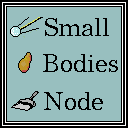

| SBN Data Reviewers: General Information |
![]()
The Planetary Data System (PDS) is an archive of data products from NASA planetary missions and supporting ground observations sponsored by the NASA Office of Space Science. A useful mission archive, as required by most NRA's and AO's, includes raw data formatted from each instrument, data calibrated in physical units, and derived products based on further processing of the data and/or combinations of different data such as maps, overlays, and comparative tables. The archive contains sufficient documentation of the mission, the instruments, and the calibrations so that future generation scientists can intelligently use and, if appropriate, even recalibrate the data on a variety of computer platforms, with no additional support. The On-Line Archiving Facility (OLAF) is a tool that data preparers can use to submit their data and supporting files to the PDS archive. OLAF imposes reasonable uniformities for all data sets in its submission process. We actively review new data and manage the archive to maximize its usefulness, and it has become a basic resource for scientists around the world.
The standards used for describing and storing data (PDS Standards Reference, Archive Structure, and Planetary Science Data Dictionary) address the details of the data set structure and hierarchy, data formats, description contents, media design, and a set of PDS terms. For reference, the basic structure of a data set is as follows. Volume files are at the top level of the data set hierarchy and give general volume descriptions, information, and indices. The volume files are in ASCII format. Catalog files, describing the circumstances and parameters of the data collection (including mission and instrument information) are found at an intermediate level of the hierarchy and are also ASCII text files. The data files are found at the lowest level and should include a separate or attached PDS label. Common data file types include, but are not limited to, Flexible Image Transport System (FITS) images and ASCII tables. The naming standard for data sets is given in the PDS Standards Reference. In general, the name will include some identifier (abbreviation or acronym) for the instrument host, target, instrument, data processing level, and version.
All PDS-produced products are peer-reviewed, well-documented, and easily accessible via a system of online catalogs that are organized by planetary disciplines. PDS is broken down into 8 discipline nodes. The Small Bodies Node (SBN) and Comet sub-node are managed at the University of Maryland under Mike A'Hearn and Ludmilla Kolokolova.
The PDS Peer Review is an essential part of the archiving process. The review presents the archive product to a set of users and asks them to verify that the data are, in fact, useful, well-formatted, and self-documenting. The reviewers can reject a data set they feel does not merit inclusion in the PDS archives, and can specify corrections and additions which must be made before a data set is considered acceptable. Representatives from the science discipline node and the PDS Engineering Node are charged with enforcing format and documentation standards, so that reviewers may concentrate on the scientific content, however reviewers may find it helpful to have at least some exposure to the PDS requirements beforehand.
![]()
![]()
Many file types found in the SBN archives and review pages are common to the planetary community. For reference, we have included a listing of file type by extension which should include all file types that a user or reviewer would encounter. This list gives a brief description of the file type and/or definition of its acronym, the location in a data set volume where the file would most likely be found, and a link, if deemed necessary, to free, downloadable software that reads the data stored in the file.
The SBN has also developed suites of small utilities for working with specific types of data most frequently encountered, and to produce formats that are preferred by the SBN (which may be more restrictive in some respects than the general PDS requirements). The routines are all written in either ANSI-standard C or Perl. All were developed and tested on a Sun Solaris work station. The source code for these routines is available from the SBN, as is, from our software archives, where they are bundled together into general packages.
The most often requested tool by our reviewers, an IDL procedure to read PDS labeled files like FITS files and tables, is also available separately here. ReadPDS is a set of IDL procedures for reading the PDS labels common to small bodies data sets. The latest release is version 4.4. This package is intended primarily for end-users of PDS data. Note that as of Version 4.2, ReadPDS requires IDL version 6.0 or later. An examples directory is included with the distribution.
Note: Programs may require slight modification to run under your own environment. In Perl routines, for example, you will likely have to change the location of the Perl interpreter invoked in the first line of the source file. In IDL, make sure your paths are set correctly so that the main program can find sub-routines.
Here are other software packages that may be of use when trying to access and manipulate data files (images, spectra and tables). Some of the software packages require PDS labels (attached or detached) and some require a FITS file with an attached FITS header. A detached PDS label will not cause a problem as long as a FITS header exists as part of the data file. Likewise, an attached FITS header will not cause a problem as long as there is an associated detached PDS label.
![]()